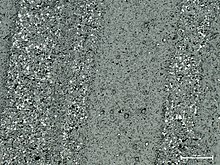Formació de ferro bandat

Les formacions de ferro bandat (també conegudes pel seu nom en anglès banded iron formations, BIF) són un tipus de roca pertanyent a les roques sedimentàries més antigues.
Hom creu que les roques de ferro bandat es formaren a l'aigua del mar com a resultat de la producció d'oxigen per part dels cianobacteris fotosintètics. L'oxigen es va combinar amb el ferro dissolt als oceans de la Terra per formar òxids de ferro insolubles, que van precipitar, formant una prima capa al fons de l'oceà. Cada banda és similar a una varva, resultant de variacions cícliques en la producció d'oxigen.
Una formació típica de ferro amb bandes consisteix en capes fines i repetides (d'uns pocs mil·límetres a uns quants centímetres de gruix) d'òxids de ferro de plata a negre, ja sigui magnetita (Fe3O4) o hematites (Fe2O3), alternant amb bandes de sílex pobre en ferro, sovint de color vermell, de gruix similar.[1][2][3][4] Una formació de ferro amb bandes individuals pot tenir fins a diversos centenars de metres de gruix i estendre's lateralment durant diversos centenars de quilòmetres.[5]
Eons i eres
[modifica]
La gran majoria de formacions de ferro bandat són de l'eó Arqueà o de l'era paleoproterozoica. No obstant això, un nombre reduït de BIF són d'edat neoproterozoica i s'associen amb freqüència, [6][7][8] si no universalment,[9] amb dipòsits glacials, que sovint contenen pedres glacials.[6] També tendeixen a mostrar un nivell més alt d'oxidació, amb l'hematita que predomina sobre la magnetita,[7] i normalment contenen una petita quantitat de fosfat, al voltant de l'1% en massa.[7] El mesobandat sovint és pobre o inexistent[10] i les estructures de deformació de sediments tous són habituals. Això suggereix una deposició molt ràpida.[11] Tanmateix, com les formacions de ferro granular dels Grans Llacs, les roques sedimentàries del Neoproterozoic es descriuen àmpliament com a formacions de ferro bandat.[6][7][11][12][13]
Referències
[modifica]- ↑ James, Harold Lloyd «Sedimentary facies of iron-formation». Economic Geology, 49, 3, 01-05-1954, pàg. 235–293. DOI: 10.2113/gsecongeo.49.3.235.
- ↑ «The significance of iron-formation in the Precambrian stratigraphic record». A: Precambrian Sedimentary Environments: A Modern Approach to Ancient Depositional Systems. Blackwell Science Ltd, 2002, p. 33–36. ISBN 0-632-06415-3.
- ↑ «Major element distribution in Archean banded iron formation (BIF): influence of metamorphic differentiation». Journal of Metamorphic Geology, 30, 5, 6-2012, pàg. 457–472. Bibcode: 2012JMetG..30..457K. DOI: 10.1111/j.1525-1314.2012.00975.x.
- ↑ Condie, Kent C. Earth as an evolving planetary system. 3. Academic Press, 2015. ISBN 9780128036891.
- ↑ «Evolution of the Hydrosphere and Atmosphere». A: Developments in Precambrian Geology. 12, 2004, p. 359–511. DOI 10.1016/S0166-2635(04)80007-0. ISBN 9780444515063.
- ↑ 6,0 6,1 6,2 Klein, C. «Some Precambrian banded iron-formations (BIFs) from around the world: Their age, geologic setting, mineralogy, metamorphism, geochemistry, and origins». American Mineralogist, vol. 90, 10, 01-10-2005, pàg. 1473–1499. Bibcode: 2005AmMin..90.1473K. DOI: 10.2138/am.2005.1871.
- ↑ 7,0 7,1 7,2 7,3 Ilyin, A. V. «Neoproterozoic banded iron formations». Lithology and Mineral Resources, vol. 44, 1, 09-01-2009, pàg. 78–86. DOI: 10.1134/S0024490209010064.
- ↑ Bekker, A; Slack, J.F.; Planavsky, N.; Krapez, B.; Hofmann, A.; Konhauser, K.O.; Rouxel, O.J. «Iron formation: the sedimentary product of a complex interplay among mantle, tectonic, oceanic, and biospheric processes.». Economic Geology, vol. 105, 3, 5-2010, pàg. 467–508. Bibcode: 2010EcGeo.105..467B. DOI: 10.2113/gsecongeo.105.3.467.
- ↑ Abd El-Rahman, Yasser; Gutzmer, Jens; Li, Xian-Hua; Seifert, Thomas; Li, Chao-Feng; Ling, Xiao-Xiao; Li, Jiao «Not all Neoproterozoic iron formations are glaciogenic: Sturtian-aged non-Rapitan exhalative iron formations from the Arabian–Nubian Shield». Mineralium Deposita, vol. 55, 3, 06-06-2019, pàg. 577–596. Bibcode: 2019MinDe..55..577A. DOI: 10.1007/s00126-019-00898-0.
- ↑ Cox, Grant M.; Halverson, Galen P.; Minarik, William G.; Le Heron, Daniel P.; Macdonald, Francis A.; Bellefroid, Eric J.; Straus, Justin V. «Neoproterozoic iron formation: An evaluation of its temporal, environmental and tectonic significance». Chemical Geology, vol. 362, 2013, pàg. 232–249. Bibcode: 2013ChGeo.362..232C. DOI: 10.1016/j.chemgeo.2013.08.002.
- ↑ 11,0 11,1 Stern, Robert J.; Mukherjee, Sumit K.; Miller, Nathan R.; Ali, Kamal; Johnson, Peter R. «~750Ma banded iron formation from the Arabian-Nubian Shield—Implications for understanding neoproterozoic tectonics, volcanism, and climate change». Precambrian Research, vol. 239, 12-2013, pàg. 79–94. Bibcode: 2013PreR..239...79S. DOI: 10.1016/j.precamres.2013.07.015.
- ↑ «Chapter 17: Chemostratigraphy of Neoproterozoic Banded Iron Formation (BIF): Types, Age and Origin». A: Chemostratigraphy: Concepts, Techniques, and Applications, 2015, p. 433–449. DOI 10.1016/B978-0-12-419968-2.00017-0. ISBN 9780124199682.
- ↑ Li, Zhi-Quan; Zhang, Lian-Chang; Xue, Chun-Ji; Zheng, Meng-Tian; Zhu, Ming-Tian; Robbins, Leslie J.; Slack, John F.; Planavsky, Noah J.; Konhauser, Kurt O. «Earth's youngest banded iron formation implies ferruginous conditions in the Early Cambrian ocean». Scientific Reports, vol. 8, 1, 02-07-2018, pàg. 9970. Bibcode: 2018NatSR...8.9970L. DOI: 10.1038/s41598-018-28187-2. PMC: 6028650. PMID: 29967405.
Bibliografia
[modifica]- Harnmeijer, Jelte P.; et al. «Banded Iron-Formation: A Continuing Enigma of Geology» (
 document editable) (en anglès). University of Washington, 2003. Arxivat de l'original el 2006-09-08. [Consulta: 26 desembre 2010].
document editable) (en anglès). University of Washington, 2003. Arxivat de l'original el 2006-09-08. [Consulta: 26 desembre 2010].
- Klein, Cornelis «Some Precambrian banded iron-formations (BIFs) from around the world: Their age, geologic setting, mineralogy, metamorphism, geochemistry, and origins». American Mineralogist, v. 90, no. 10, 10-2005, pàg. 1473-1499 [Consulta: 26 desembre 2010]. «resum»
